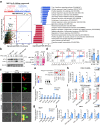Systematic investigation of chemo-immunotherapy synergism to shift anti-PD-1 resistance in cancer
- PMID: 38609378
- PMCID: PMC11015024
- DOI: 10.1038/s41467-024-47433-y
Systematic investigation of chemo-immunotherapy synergism to shift anti-PD-1 resistance in cancer
Abstract
Chemo-immunotherapy combinations have been regarded as one of the most practical ways to improve immunotherapy response in cancer patients. In this study, we integrate the transcriptomics data from anti-PD-1-treated tumors and compound-treated cancer cell lines to systematically screen for chemo-immunotherapy synergisms in silico. Through analyzing anti-PD-1 induced expression changes in patient tumors, we develop a shift ability score to measure if a chemotherapy or a small molecule inhibitor treatment can shift anti-PD-1 resistance in tumor cells. By applying shift ability analysis to 41,321 compounds and 16,853 shRNA treated cancer cell lines transcriptomic data, we characterize the landscape of chemo-immunotherapy synergism and experimentally validated a mitochondrial RNA-dependent mechanism for drug-induced immune activation in tumor. Our study represents an effort to mechanistically characterize chemo-immunotherapy synergism and will facilitate future pre-clinical and clinical studies.
© 2024. The Author(s).
Conflict of interest statement
The authors declare no competing interests.
Figures






Update of
-
Systematic investigation of chemo-immunotherapy synergism to shift anti-PD-1 resistance in cancer.Res Sq [Preprint]. 2023 Sep 14:rs.3.rs-3290264. doi: 10.21203/rs.3.rs-3290264/v1. Res Sq. 2023. Update in: Nat Commun. 2024 Apr 12;15(1):3178. doi: 10.1038/s41467-024-47433-y. PMID: 37790509 Free PMC article. Updated. Preprint.
References
MeSH terms
Grants and funding
LinkOut - more resources
Full Text Sources
Medical
Research Materials

